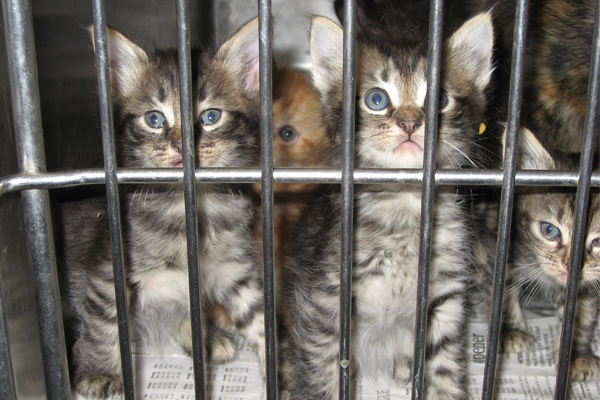The Life–Saving Impact of Shelter Medicine
by Alexis Fasseas | Oct 31, 2012
Large rooms filled with small, sterile cages, echoing cries and whimpers and loud barking. People with clipboards walking by, keeping lists of who will live to see another day and whose life will be extinguished. There is method to the madness. A single sneeze, a stuffed nose, a throaty cough, teary eyes, loose stool: all calculated offenses for a death sentence. But mere proximity counts, too. The offending cat or dog will be killed, and so will the cats or dogs in cages immediately surrounding the offender. A single incident of more virulent diseases warrants a culling of the entire population. Hundreds of dead, furry bodies pile in refrigerators, awaiting transport to a large incinerator – in Chicago, it’s located on Goose Island. Ash in the air is a mixture of industry and the remains of thousands of dead cats and dogs. This is herd management. It’s common practice at large open-door humane societies. It doesn’t have to be this way.

The old and out-dated model of running private shelters as a revolving door of unlimited intake and frequent death is being supplanted by the No Kill movement and the burgeoning field of shelter medicine. While No Kill shelters have always been dedicated to the life of each individual pet in their care, shelter veterinary protocols historically mimicked private veterinary practices. But the David Duffield family’s foundation Maddie’s Fund had a vision for a new approach. (Read more about the Duffield family, recipient of the first PAWS Chicago Visionary Award, on page 26.) Animals living in shelters are very stressed and exposed to a drastically different environment than pets living in a home; treatment needs to be customized to handle these diverging medical needs. Additionally, veterinary medicine staff need to be trained for these specific shelter circumstances to optimize the health and management of a large population of animals and ensure the best care for each individual pet.
In 2001, Maddie’s Fund established the nation’s first comprehensive shelter medicine program at UC Davis, resulting in the first shelter medicine residency program and the nation’s first shelter medicine website. To date, Maddie’s Fund has funded grants at nine colleges of veterinary medicine, including Purdue University, University of Florida and Cornell University. Just this year shelter medicine has been accepted as a recognized specialty by the American Board of Veterinary Practitioners and the guidelines for board certification are currently being developed.
In 2008, Purdue University School of Veterinary Medicine collaborated with PAWS Chicago and received a Maddie’s Shelter Medicine grant. Maddie’s Fund also supports PAWS Chicago’s Shelter Medicine program with equipment and veterinary staffing expenses. As a result, PAWS Chicago became one of the first animal welfare organizations in the Midwest to integrate shelter medicine into its operations and is a leading shelter in innovative best practices. Additionally, leading scientific studies on shelter medicine are being performed by Purdue at PAWS Chicago today. This research will transform shelter medicine of tomorrow.
PAWS Chicago’s Rescue & Recovery Center is the first stop for all PAWS dogs and cats.
Large suites with soft bedding, toys, discreet airflow and piped in classical music help homeless pets relax and prevent the spread of disease. An expert shelter medicine veterinary team examines each pet utilizing a case management approach, diagnosing and establishing a protocol based on the needs of each individual animal. Puppies and kittens enjoy the love and socialization of foster homes until they are able to receive their second vaccination. So do pets with injuries or illnesses that will require a longer recovery time.
